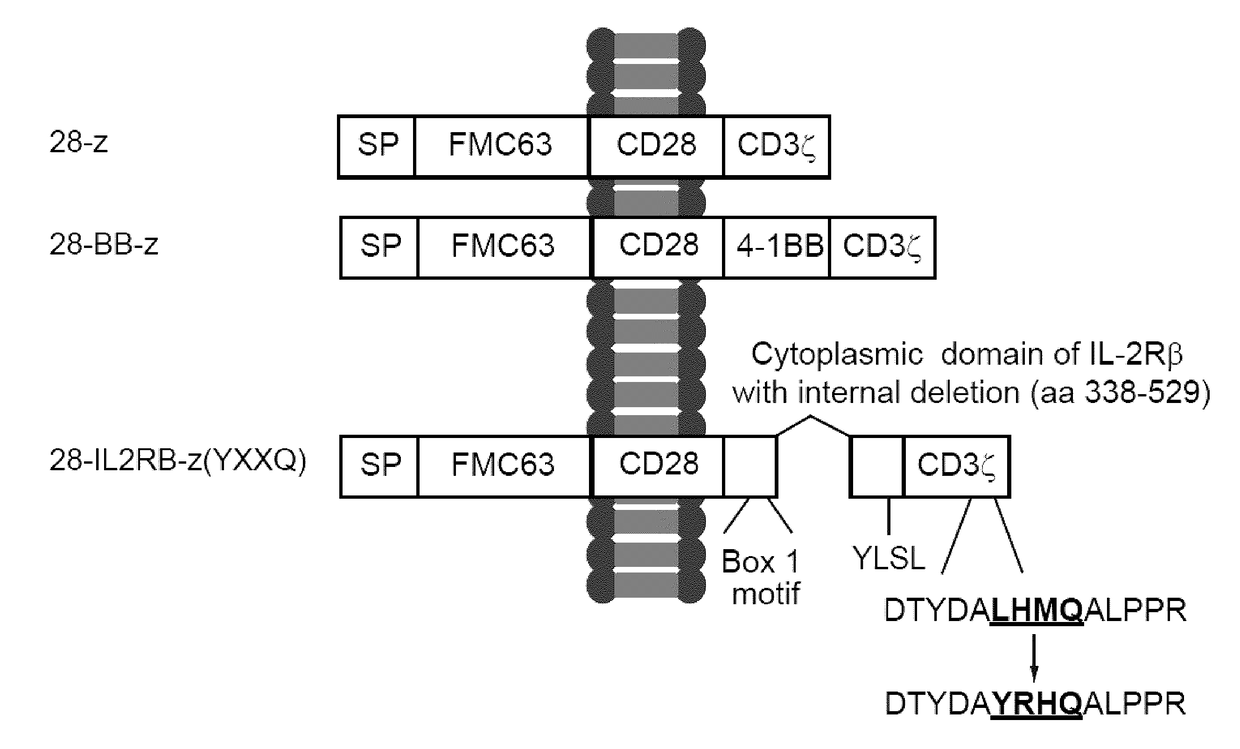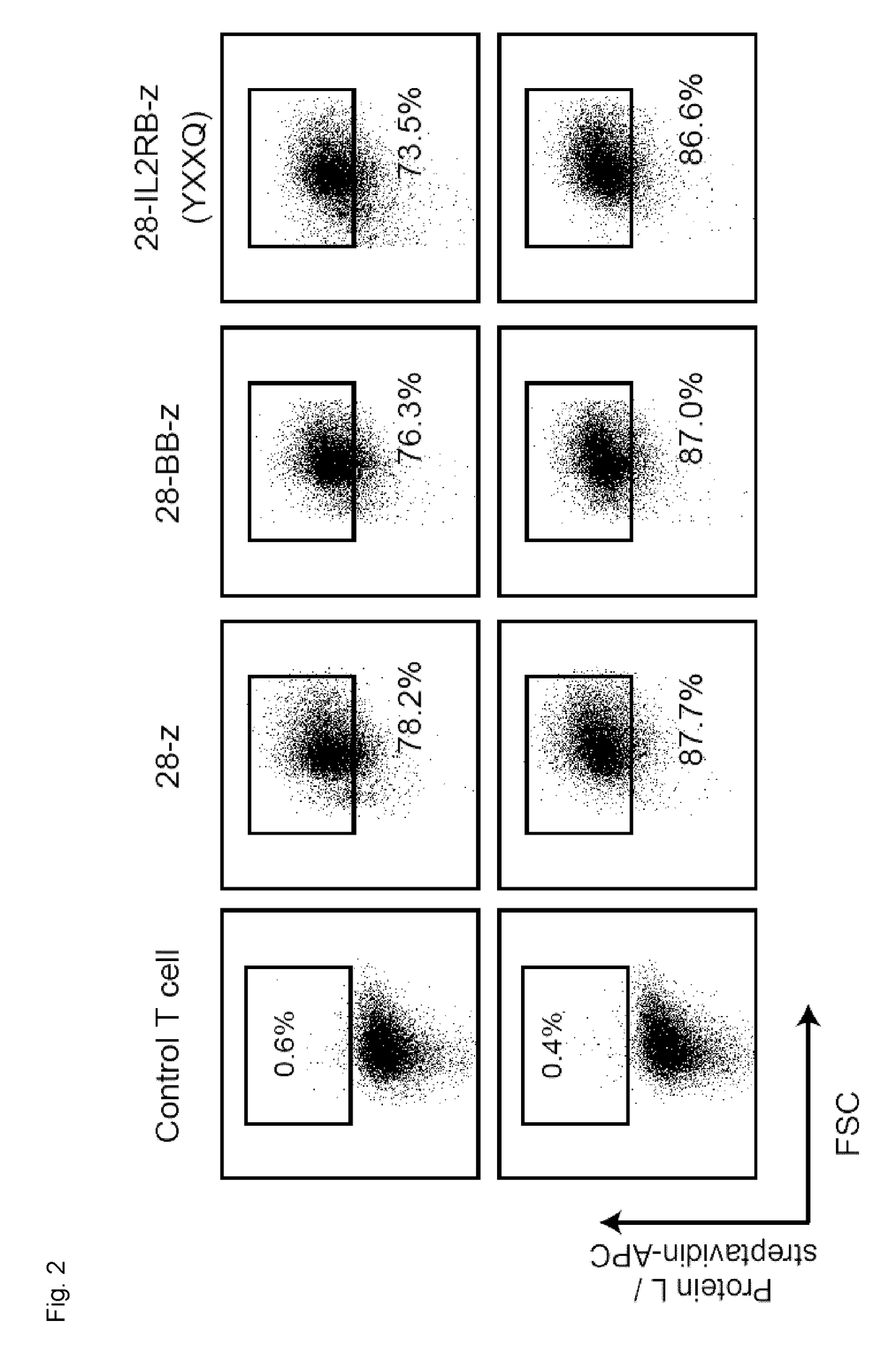Chimeric Antigen Receptors
a technology of chimeric antigen and receptors, which is applied in the direction of peptide/protein ingredients, immunological disorders, drug compositions, etc., can solve the problems of limited reports of signal transducers used as co-stimulatory intracellular signaling domains for the second and third generation cars
- Summary
- Abstract
- Description
- Claims
- Application Information
AI Technical Summary
Benefits of technology
Problems solved by technology
Method used
Image
Examples
example 1
Anti-CD19 Chimeric Antigen Receptor (CAR) Constructs
[0218]A FMC63-derived single-chain variable fragment (scFv) (Nicholson et al., 1997) has been linked to CD28 and CD3ζ chain (28-z, 2nd generation), CD28, 4-1BB and CD3ζ chain (28-BB-z, 3rd generation), or CD28, cytoplasmic domain of IL-2 receptor β chain with internal deletion, and CD3ζ chain with an exogenous YXXQ motif (SEQ ID NO: 13) has been introduced for STAT3 binding (28-IL2RB-z (YXXQ)), as shown in FIG. 1. The YXXQ (SEQ ID NO: 13) motif was generated by substituting Leu-His-Met residue at position 156-158 encoded by CD3ζ chain for Tyr-Arg-His. FMC63 is an IgG2a mouse monoclonal antibody belonging to the CD19 cluster. Oncostatin M was used as a signal peptide. Gibson Assembly Method was used for site-directed mutagenesis. The following primers were used: ACGCCTATCGCCATCAGGCCCTGC (SEQ ID NO: 26), and CTGATGGCGATAGGCGTCGTAGGTGT (SEQ ID NO: 27).
Transduction Efficiency of Primary T Cells with Anti-CD19 CAR Constructs
[0219]To det...
example 2
Protocol for Anti-CD19 CAR Construct T Cell Transduction and Expansion
[0223]Peripheral CD3′ T cells were stimulated with mOKT3 / aAPC, and retrovirally transduced with individual CD19 CARs for three consecutive days. The CAR-transduced T cells were stimulated with irradiated K562-CD19 cells or K562 cells in the presence of IL-2 100 IU / mL and IL-15 10 ng / mL at an E:T ratio of 2:1 in a weekly manner where indicated (see FIG. 6). Variations of E:T ratio and duration of transduction can be envisaged. For example, the CD3+ T cells stimulated with mOKT3 / aAPC can be transduced for three consecutive days at an E:T ratio of 10:1.
Expansion of CAR-Transduced T Cells Following Transduction
[0224]Fold expansion of CAR-transduced T cells is shown (n=4) in FIG. 7. Greater than 100-fold expansion of CD8+ T cells was obtained in 2 weeks in all the CAR-transduced T cells. The 28-BB-z CAR-transduced T cells showed significantly superior proliferation compared to the 28-z CAR-transduced T cells following ...
example 3
Viability the CAR-Transduced T Cells
[0229]CAR-transduced T cells were stimulated with K562-CD19 cells at a ratio of 2:1. The frequency of dead cells was evaluated by flow cytometry 3 days following stimulation (n=4) (FIG. 12). Error bars depict S.D. The T cells transduced with the 28-IL2RB-z (YXXQ) CAR construct showed decreased apoptosis upon antigen stimulation. Significance of difference was evaluated by the paired t test. The data presented in FIGS. 11 and 12 demonstrate that the proliferative advantage of the 28-IL2RB-z (YXXQ) CAR+ T cells upon CD19 stimulation resulted from both enhanced cell division and decreased apoptosis.
Surface Phenotype of CAR-Transduced T Cells
[0230]CAR-transduced T cells were stimulated with K562-CD19 at a ratio of 2:1. Surface CD45RA and CD62L on CD4+ and CD8+ T cells were stained by specific mAbs and subjected to flow cytometry analysis 7 days following stimulation (FIG. 13). Representative data of 4 independent experiments is shown. The T cells tran...
PUM
| Property | Measurement | Unit |
|---|---|---|
| pH | aaaaa | aaaaa |
| nucleic acid | aaaaa | aaaaa |
| frequency | aaaaa | aaaaa |
Abstract
Description
Claims
Application Information
 Login to View More
Login to View More - R&D
- Intellectual Property
- Life Sciences
- Materials
- Tech Scout
- Unparalleled Data Quality
- Higher Quality Content
- 60% Fewer Hallucinations
Browse by: Latest US Patents, China's latest patents, Technical Efficacy Thesaurus, Application Domain, Technology Topic, Popular Technical Reports.
© 2025 PatSnap. All rights reserved.Legal|Privacy policy|Modern Slavery Act Transparency Statement|Sitemap|About US| Contact US: help@patsnap.com



